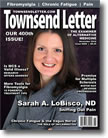|
![]()
From the Townsend Letter |
|||
Potential Proof of Chemical Sensitivities by Laurie Dennison Busby, B.Ed. |
|||
Page 1, 2 7) ENZYMES NEEDED TO BREAK DOWN CHEMICALS: POLYMORPHISMS & DECREASED LEVELS/ACTIVITY For several compounds tested, the rate of olfactory mucosa metabolism from parent compound to subsequent compound was 3 to 65-fold higher than hepatic.45 If the body has a greater need for xenobiotic metabolizing enzyme activity in the olfactory mucosa, possibly as a first line of defense from airborne chemicals that might enter the CNS, then lower levels or activity of these enzymes in olfactory mucosa may expose patients to higher levels or longer effects of airborne chemicals. In MCS, CFS, and FM, some enzymes involved in xenobiotic metabolism have been found to have polymorphisms or lower levels or activity: cytochrome P450 (CYP2C9 and CYP2D6), glutathione S transferases (GSTM1 and GSTT1), N-acetyltransferases (NAT), and/or paraoxonase (PON).46,47 Lower activity of PON, which breaks down some organophosphate pesticides, has been found in FM; Hashimoto's thyroiditis/hypothyroidism, which is often a comorbidity in CFS and MCS; and Graves disease/hyperthyroidism.13,48-50 8) THE MOUTH/THROAT 9) THE SKIN 10) THE LYMPH NODES CONCLUSION Over two decades ago, Meggs theorized neurogenic inflammation might play a role in MCS. Over 15 years ago, Millqvist found patients with MCS and asthma-like symptoms were more sensitive to inhaled capsaicin and responded to lidocaine indicating MCS may, "originate in the sensory nervous system."32 Yet, MCS is still at a crossroads. Patients deserve better. Hopefully, this paper has provided enough "potential proof" researchers will stop debating the issue and instead finally move on to finding answers. (Thank you to the researchers who have been tirelessly looking for answers all along.) Notes .pdf Page 1, 2 ©2016 Laurie Dennison Busby, B.Ed.
|
|||
![]()
Consult your doctor before using any of the treatments found within this site.
![]()
Subscriptions
are available for
Townsend Letter, the Examiner of Alternative Medicine
magazine, which is
published 10 times each year. Search our pre-2001
archives for further information. Older issues of the printed magazine
are also indexed for your convenience.
1983-2001
indices ; recent indices. Once you find the magazines you'd like to order, please
use our
convenient form, e-mail subscriptions@townsendletter.com,
or call 360.385.6021.
360.385.6021
Fax: 360.385.0699
info@townsendletter.com
Who are
we? | New articles | Featured
topics | e-Edition |
Tables of contents | Subscriptions | Contact
us | Links | Classifieds | Advertise |
Alternative
Medicine Conference Calendar | Search site | Archives |
EDTA Chelation Therapy | Home
© 1983-2016 Townsend Letter
All rights reserved.
Website by Sandy
Hershelman Designs




